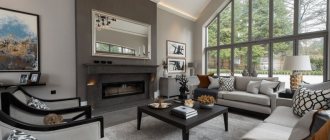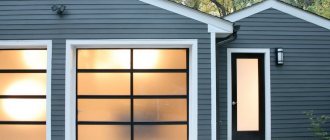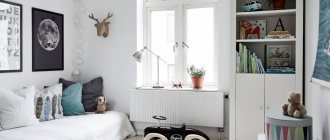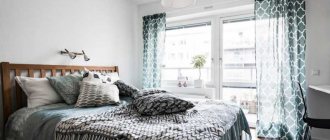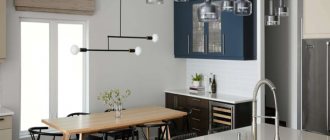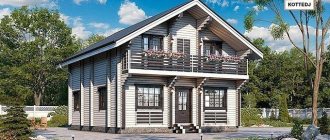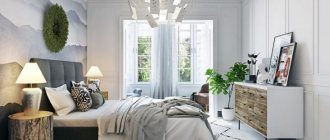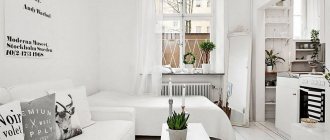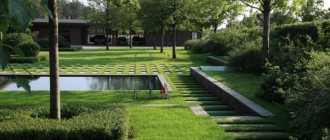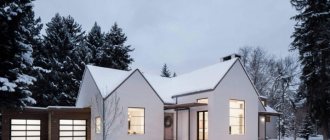Furniture and appliances
In kitchen design, the Scandinavian style is recognizable by the small amount of furniture. Even in spacious rooms, only the essentials remain to add airiness, fill the house with light, and create a feeling of freedom.
The main principles of Scandinavian interior – simplicity and functionality – can be seen in the choice of furniture. Everything should be as concise as possible:
- comfortable spacious wardrobes;
- predominantly built-in technology;
- smooth plain facades.
The main principles of the interior are simplicity and functionality
When thinking about Scandinavian furniture, the first thing that comes to mind is the Swedish company IKEA. The corporate style of this company has spread the idea of Scandi interior throughout the world. Their catalogs are a source of ideas and inspiration in kitchen design.
Kitchen set
Color. I won’t surprise anyone by saying that the most popular color for kitchen furniture is white. At the same time, the room looks spacious and interesting. This is achieved through a soft contrast with the countertop, chrome appliances or voluminous textured backsplash.
Kitchens with wooden or painted facades add home comfort and warmth to the Scandinavian interior.
Finishing. The paints used are matte or semi-gloss. Bright gloss is also found, mainly in very small kitchens. This is how furniture doors reflect light and create additional depth of space.
Shelves. Open top shelves are a popular feature of the Scandinavians. They can be distinctly simple, with contrasting metal holders. This way, beautiful dishes are placed in a visible place and create additional comfort.
Another option is tall upper cabinets that reach to the ceiling. This way the space is visually stretched and not broken into parts. The issue of storing various kitchen items is being resolved.
Tall upper cabinets reaching to the ceiling
Facades. A smooth façade is more common than others. Especially if the kitchen gravitates towards a modern interpretation of the Scandinavian style. In this case, the handles should support the idea of simplicity. Brackets, rails or push-pull mechanisms are ideal.
Scandinavian interior can have a touch of classics. Then framed facades with minimal milling and push-button handles become relevant.
Hitarp facades from IKEA will bring a share of rustic romance. Shell handles, a couple of wicker ornaments and the Scandinavian style takes on a country feel.
Smooth façade is more common than others
Tabletop
The choice of countertop is usually determined by the budget.
- The most successful option is a table top made of solid wood. The color of natural wood fits perfectly into the overall light tone of the interior, making it warmer and more comfortable.
- When a stronger contrast is required, a solid black or gray stone countertop is suitable.
- A budget alternative for inexpensive sets is a tabletop made of waterproof chipboard. Natural veneer can easily replace solid wood, and a special film imitates metal or stone.
The color of natural wood fits perfectly into the overall light tone of the interior
Dinner Zone
An important difference between Scandinavian furniture is regular and simple lines. Here you can find traditional wooden furniture and lightweight structures made from modern materials.
The thin legs of such tables set the dynamics with their unusual geometry.
The classic wooden table is made of solid bleached oak, pine or beech. Its color supports the shade of the tabletop or chair legs.
Wood is often painted white, gray or anthracite.
The high contrast with the rest of the furniture draws attention to the dining area. Monochrome is a good base for bright decorative elements
Correct and simple lines
In a small kitchen, a table-book or a compact breakfast table in the Scandinavian style and a pair of bright chairs would be appropriate. Often the table is replaced by a small bar counter along the wall.
An alternative option is a transforming table. It is suitable for very modest spaces, when a folding or pull-out tabletop is the only way to dine at a full table.
Arranging a comfortable dining area is unthinkable without high-quality chairs and compact sofas in neutral or bright colors. Decorative pillows on them will unite all the kitchen textiles and complete the composition.
Small kitchen in a given style
Chairs in a Scandi kitchen are always a source of pride. They can be wooden with a curved back in a retro spirit or emphatically modern made of plastic and metal. Often chairs are the only color accent in the kitchen; it looks very fresh.
Legendary designer chairs are also not uncommon. The compact “Ant” chair by Arne Jacobsen or the bright, conceptual chairs of the Eames couple.
Colors used to decorate a Scandinavian style façade
As mentioned earlier, the color range here is limited and includes 5 colors: black, gray, white, wood and beige. Your sense of personal taste and the surrounding landscape design will help you choose the optimal solution.
White color will give the house lightness and airiness; this option is the most popular in the northern part of Europe. Also, the advantage of the solution is that such houses reflect sunlight, of which there is not very much there. To create the perfect composition, you can use a combination of light and dark colors, for example, white will be combined with wood or ivory.
Black color for exterior decoration of a house is a solid and concise style, but not practical, as it quickly fades under the influence of ultraviolet sunlight. Decorating a house with wood is a popular and practical option that can make the building cozy and comfortable. Also, the advantage lies in the naturalness of the material and its environmental friendliness, but great attention must be paid to the pre-treatment of wood.
Gray color is laconic and practical, since dust does not catch the eye, and dark shades of gray are the most resistant to ultraviolet radiation. Gray is a universal color, so it can be combined with both warm and cold colors. The last, but no less attractive solution would be to use beige color, as the house will have a noble and discreet appearance. In order to set off a light shade, it is better to use black window frames and doors.
Fireplace - an attribute of the Scandinavian style in the house
This is simply a necessary attribute of the Scandinavian direction, which will provide coziness and a comfortable stay.
There are no special restrictions when choosing a fireplace design. It can be brick or cast iron, in an old or modern style. Here it is exclusively according to your taste and desire. You can even make the finish from soapstone, which is a stone that retains heat very well.
Doors and windows of a Scandinavian style house
A Scandinavian-style private house has non-standard windows and doors, the dimensions of which are due to the lack of natural light in Scandinavian countries. In order to maximize access to sunlight inside the house, large, often panoramic windows are used. Thanks to them, a feeling of spaciousness is created and the originality of the design is emphasized.
It is worth noting that similar window designs appeared in this style not so long ago, this is explained by the development of modern technologies, the emergence of technologically advanced structures that can cope with the load placed on them. The whole point is that large glazing should not affect the comfort and microclimate inside the house in any weather conditions. We also must not forget that such buildings require high-quality thermal insulation; for this purpose, expensive materials are chosen that can 100% cope with the task.
Probably no one will be surprised by the fact that huge windows with wooden frames easily and quickly took root in Scandinavian-style houses, as they emphasize the design of the building. Plastic analogues are practically not used here, since they have high thermal conductivity. Wood, in turn, retains heat inside the house much better, while maintaining a comfortable temperature in the house and is environmentally friendly.
As for the doors, they usually practically do not stand out against the general background of the facade. In most cases, they have a design similar to windows, repeating their shapes and colors. In general, this style has great similarities with modern minimalism. If you decide to dilute the “grayness” of the building with elements of country style, then you can use openings in blue, pink, yellow or lilac. Such bright accents will make the facade more rich and attractive, while maintaining Scandinavian restraint and simplicity.
Everything you need to know about Scandinavian style
The Scandinavian design style is one of the most sought after and popular in the world.
Yes, yes, it is more popular even than the high-tech, classic and Provence styles. And all thanks to... Ikea!
But first things first.
The history of the origin of the Scandinavian style
Firstly, only three states belong to the Scandinavian countries: Sweden, Norway and Denmark. Neither Iceland, nor Finland, nor any other neighbors are the progenitors, carriers and standards of the Scandinavian style. Even despite the superficial similarity of the interiors, the homes of the Scandinavian neighbors have their own special authentic features.
Secondly, the inhabitants of Northern Europe (like any other inhabitants of any other country in the world) have been building their houses since time immemorial. And, naturally, they built them in accordance with their needs and needs.
Do you want to understand what?
Then imagine: it’s cold, a very harsh climate, all around there is snow, forests and mountains, the sun peeks out from behind the clouds on a limited number of days a year, you have a huge amount of bulky warm clothes... What kind of house would you like to live in?
Obviously, warm, light, bright and with a spacious storage system.
These are exactly the kind of houses that the Scandinavians built.
But before the twentieth century, there was no mass production of anything, so the interiors were more of an artisanal nature than the modern Scandinavian style that is now familiar to the entire planet. The traditional Scandinavian style still exists today in the world of interior design, but it, like any ethnic trend, is more of a local flavor and a unique twist than a mass trend.
The history of the classic modern Scandinavian style began in the twentieth century along with the development of mass industry. Moreover, the Scandinavian style has become a kind of quintessence of the Nordic countries’ orientation towards sociality and democracy.
Swedish social policy is considered the most thoughtful and focused on ordinary people. According to its postulates, all benefits should be equally available to both rich and poor. And this is more than noticeably reflected in the interior design of the Nordic countries. Indeed, with the creation of technologies for mass processing of natural wood, the reduction in cost of technological processes, the invention of plywood and plastic and, as a consequence, the development of mass furniture production, the interior has ceased to be an indicator of status and financial capabilities.
It has become concise, functional, comfortable, high quality and carefully checked by the control service, but most importantly - affordable.
The emergence of modern Scandinavian style culminated in the opening of the first Ikea store in Sweden in the 1950s. The concept of the store resonated with the masses so much that it confidently began its journey around the planet, and the brand became the most recognizable furniture brand.
Scandinavian apartment: features, colors, materials
In a modern Scandinavian apartment, light powdery shades predominate and black and white contrasting monochrome decorative elements are very common.
The most commonly used colors are white, light gray, light blue, beige, yellow.
Bright textile accents are welcome.
Most of the materials used for Scandinavian interior design are natural wood and especially teak (for a long time Denmark was the main supplier of teak on the world market).
However, today one can observe a general tendency for natural materials to become more expensive, so synthetic ones that imitate natural ones are increasingly being used in classic Scandinavian interiors.
Who is Scandinavian style suitable for?
- For those who value comfort
- For those who like simplicity
- For those who are not used to wasting money
And:
- For those who require a spacious storage system for things and accessories
- For those whose apartments are not very large. Thanks to light shades, it will visually expand the space
- For those who have little light in their apartment
